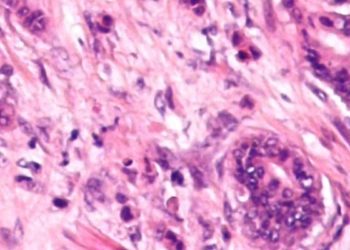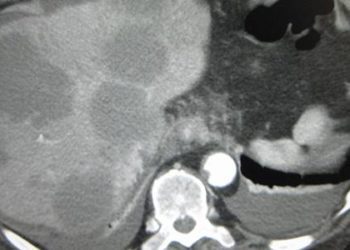Detection of advanced colorectal neoplasia by CT colonography comparable to optical colonoscopy [Classics Series]
This study summary is an excerpt from the book 2 Minute Medicine’s The Classics in Medicine: Summaries of the Landmark Trials
1. Computed tomographic colonography (CTC) and optical colonoscopy (OC) screening strategies resulted in similar detection rates of advanced neoplasia.
2. Rates of positive screening based on polyp size were achieved through CTC with significantly fewer adverse events compared to OC.
Original Date of Publication: October 2007
Study Rundown: Advanced neoplasia of the colon consists of adenocarcinomas and advanced adenomas, the latter of which are associated with a high risk of progression to cancer. Due to their potential to transform into invasive lesions, the early detection and removal of advanced adenomas represent key steps in reducing colorectal cancer mortality. Historically, fecal occult blood testing and sigmoidoscopy were used as primary screening tools. However, it was later found that over a third of colonic polyps are located proximal to the splenic flexure, rendering these methods inadequate in screening the entire colon. It was not until years later that single contrast barium enema (SCBE), and then double contrast barium enema (DCBE) emerged as the first radiologic imaging tests allowing for the detection of colonic neoplasms. Owing to the technically demanding and time-consuming nature of these imaging studies, the barium enema was later replaced by CTC as the primary imaging test used in colorectal cancer screening. In a prior prospective cohort conducted by Yee and colleagues, in which 300 patients underwent CTC followed by standard colonoscopy, CTC had a high sensitivity in the detection of clinically important polyps. In the present study conducted by Kim and colleagues, CTC was compared to OC in the detection of advanced adenomas and adenocarcinomas. The results of this study showed that the total number of advanced neoplasms detected through CTC was similar to that detected by primary OC, with CTC requiring significantly fewer polypectomies to achieve these outcomes. While the rate of colonic perforations in the primary OC group was within an expected range, no serious complications were reported as a result of CTC.
Click to read the study in NEJM
In-Depth [non-randomized trial]: The results of a CTC screening program were compared to those of an OC screening program. Patients in each study group were consecutively enrolled, with partially overlapping time periods, from the same general screening population and geographic region. Key exclusion criteria included polyp surveillance, history of a bowel disorder (i.e. inflammatory bowel disease), polyposis syndromes, and hereditary nonpolyposis colorectal cancer (HNPCC) syndrome. Polyps were defined as large if measuring at least 10 mm in size, small if between 6-9 mm, and diminutive if 5 mm or less. As part of CTC preparation, 250 mL of 2% barium and 60 mL of diatrizoate were administered to tag residual stool and fluid, respectively. Colon distention was achieved through automated delivery of carbon dioxide. All CTC imaging studies were reviewed by 1 of 5 gastrointestinal radiologists and, where present, polyps were measured with electronic calipers. For all polyps >6 mm, same-day therapeutic OC was offered unless contraindicated. Patients with only 1-2 polyps measuring between 6-9 mm were also given the option of CTC surveillance only. Polyps identified through OC were measured through in vivo OC estimation and removed with standard techniques. A total of 3120 (mean age 57 years, SD 7.2 years; 44% male) and 3163 patients (mean age 58.1 years, SD 7.8. years; 44% male) underwent primary CTC and primary OC, respectively. Following primary CTC, 246 patients (7.9%) were referred for therapeutic OC. The total number of polyps removed in patients that underwent primary OC was 2434, far exceeding the 561 that were removed in patients who underwent primary CTC (p <0.001). However, there were no statistically significant differences between groups with respect to the number of large (p = 0.92) or small (p = 0.14) advanced adenomas removed. The two screening strategies also had similar rates of positive screening results based on size threshold for polyps measuring ³10 mm (p = 0.06) and ³ 6 mm (p = 0.59). While there were no perforations or serious complications related to CTC or subsequent therapeutic OC, colonic perforation occurred in 7 (0.2%) patients in the primary OC screening group, of which 4 required surgical repair.
Kim DH, Pickhardt PJ, Taylor AJ, Leung WK, Winter TC, Hinshaw JL, et al. CT colonography versus colonoscopy for the detection of advanced neoplasia. The New England Journal of Medicine. 2007 Oct;357(14):1403-12.
Additional Review:
Levine MS, Yee J. History, Evolution, and Current Status of Radiologic Imaging Tests for Colorectal Cancer Screening. Radiology. 2014 Nov;273(2S):S160-S80.
Yee J, Akerkar GA, Hung RK, Steinauer-Gebauer AM, Wall SD, McQuaid KR. Colorectal Neoplasia: Performance Characteristics of CT Colonography for Detection in 300 Patients 1. Radiology. 2001 Jun;219(3):685-92.
©2022 2 Minute Medicine, Inc. All rights reserved. No works may be reproduced without expressed written consent from 2 Minute Medicine, Inc. Inquire about licensing here. No article should be construed as medical advice and is not intended as such by the authors or by 2 Minute Medicine, Inc.





![The ABCD2 score: Risk of stroke after Transient Ischemic Attack (TIA) [Classics Series]](https://www.2minutemedicine.com/wp-content/uploads/2013/05/web-cover-classics-with-logo-medicine-BW-small-jpg-75x75.jpg)
